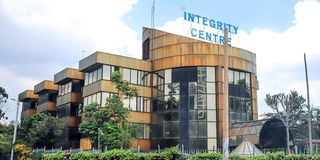EACC goes for high-profile asset recovery as quicker way to punish corrupt individuals
Sponsored by Ethics and Anti-Corruption Commission

EACC head office in Nairobi.
By Millicent Mwololo
The Ethics and Anti-Corruption Commission (EACC) has filed a recovery suit for assets worth Ksh74 million against Migori Governor Okoth Obado. This is the latest among a series of high-profile asset recovery cases by the Kenyan anti-corruption body. Migori county has lost close to Ksh2 billion to corruption.
Asset recovery is part of EACC’s 2018-2023 strategic plan, which also focuses on high-impact investigations.
For EACC, the criminal approach to high-profile corruption cases tends to be complex, requiring the Commission to interact with other stakeholders, such as the Office of the Director of Public Prosecutions (ODPP) and the Judiciary. “In criminal cases, the standard of proof is high; beyond reasonable doubt,” says Mr Phillip Kagucia, Advocate, Assistant Director and Head of Corporate Communications at EACC.
The asset recovery approach, on the other hand, follows a civil process where the standard of proof is lower. “As an advocate, what I need to show is that someone has acquired an asset illegally,” says Mr Kagucia. This is a win for EACC, especially in corruption cases against high-profile individuals. It yields results quicker with fewer obstacles.
Still, according to Mr Kagucia, asset recovery is not easy. EACC follows the process because it is provided for in the law. There are other provisions in the law, such as Article 2(6) of the Constitution, which states that international treaties that have been ratified by Kenya also become part of the law. This is one of the many tools that EACC uses to fight corruption within the courts.
Corruption, says Mr Kagucia, is a crime of calculation. Before engaging in corruption, many individuals will have already calculated the risks and the rewards. EACC knows this too well. “If the risk of being sent to prison is low and the reward is high, a corrupt individual will steal. However, using asset recovery, EACC is taking away the reward,” Mr Kagucia states matter-of-factly. Asset recovery therefore becomes a disincentive to corruption.
In July 2019, two years after Mr Kagucia had successfully argued cases on forfeiture of unexplained wealth, EACC won big against corruption when the High Court ordered former Nairobi City Council Finance Executive Jimmy Mutuku Kiamba to forfeit Ksh317 million worth of unexplained assets. Anti-Corruption Court judge Hedwig Ong’udi ruled that Kiamba had failed to satisfactorily explain the source of his assets. EACC had told the court that it had investigated activities of Kiamba’s 11 bank accounts, dating from August 2009 to January 2015, and had found that the deposits were way beyond his legitimate income.

Mr Phillip Kagucia, Advocate, Assistant Director and Head of Corporate Communications at EACC.
To put the figure into perspective, Ksh317 million is just about the same amount of money that the national government spent in July 2019 to purchase and distribute relief food in 15 drought-stricken regions in Garissa, Mandera, Wajir, Marsabit, Tharaka Nithi, Isiolo, Kitui, Makueni, Tana River, Laikipia, Embu, Kilifi, Nyeri, Lamu and Baringo counties.
EACC has also recovered Ksh112 million from former Senior Assistance Accountant General at the Interior Ministry Thomas Njogu.
And in April 2020, the commission succeeded in recovering Ksh18 million from Dr Salome Munubi, a former land valuation director with the National Lands Commission. The unexplained money had been confiscated from her house in 2017 by EACC officials.
This trend in asset recoveries is consistent with the commission’s 2018-2023 strategic plan.
Major Twalib Mbarak’s tenure as CEO at the EACC has registered successes in asset recoveries. Since he took over in 2019, there has been an increase in the value of the assets recovered by the EACC, and there has also been a rise in the number of high profile people prosecuted on corruption charges, among them nine county governors.
According to EACC, Kenya is losing an estimated Ksh608 billion – equivalent to 7.8 percent of the national GDP – to corruption annually.
In the last five years, the Commission has seized over Ksh25 billion in assets and averted the loss of Ksh30.4 billion worth of others. This, against a budget of Ksh12 billion in the same period, is a big win for the country, as there is noticeable value for money in the work that the commission is doing.
However, the net effect is being felt in what the recovered amounts are able to do for Kenyans.
The law requires that EACC takes the money back to Treasury. The Commission follows up on the utilisation of the recovered assets, Mr Kagucia says. But there is a general feeling among Kenyans that the recovered money is going back to a place where it is still at risk of being misappropriated.
In view of this, EACC has made two proposals. The first option is to have a Criminal Assets Recovery Fund where proceeds of corruption and money laundering can be put together to finance the training of law enforcement officers, and buy vehicles and equipment such as computers, cameras and other technology gadgets to aid law enforcement and investigations.
The second option is to have the money being repatriated back into Kenya from other countries to be returned in kind.
For instance, in 2016, Ksh52 million ‘Chickengate” money recovered from a British firm whose officials were jailed for bribing Kenya’s electoral agency officials, was used to buy ambulances for the country. This followed a directive by the UK government that such money could not be sent to the Exchequer, but rather must go to social and development projects.
Some more money, amounting to Ksh350 million, is expected back into Kenya from Jersey Islands. The money is to be returned in kind.


